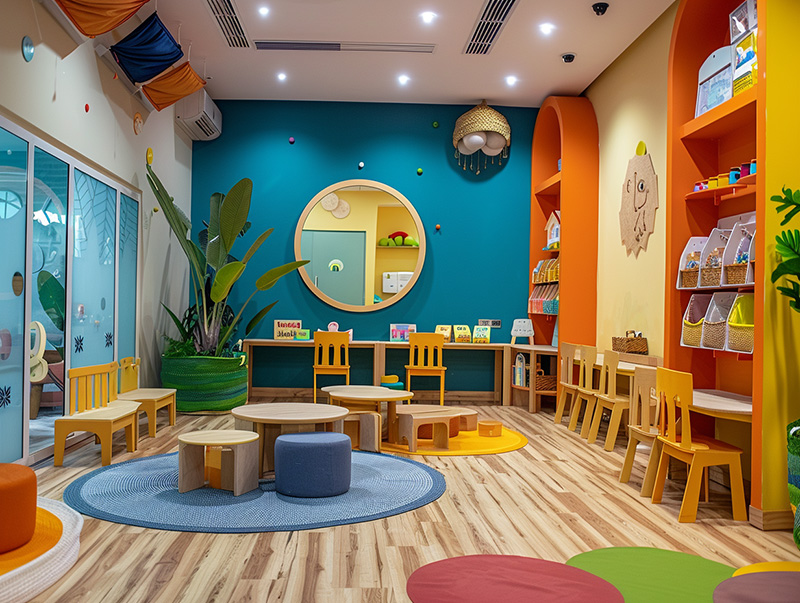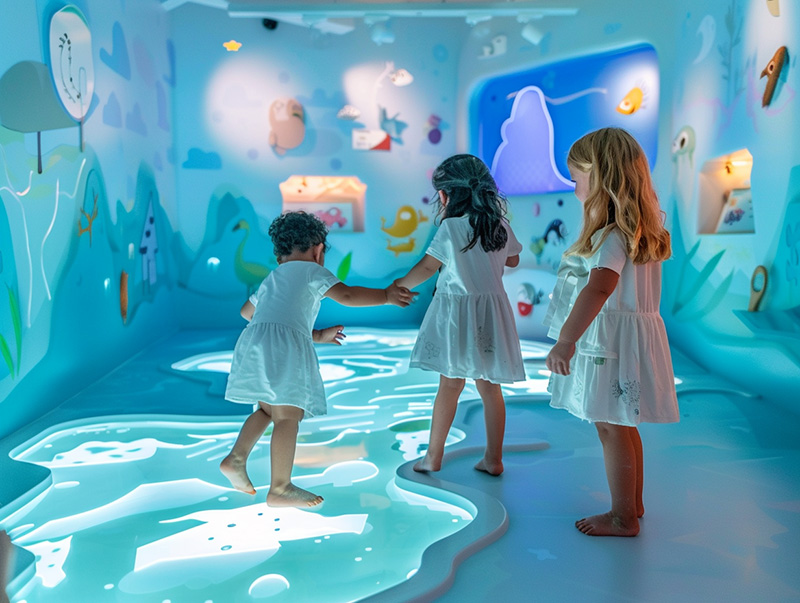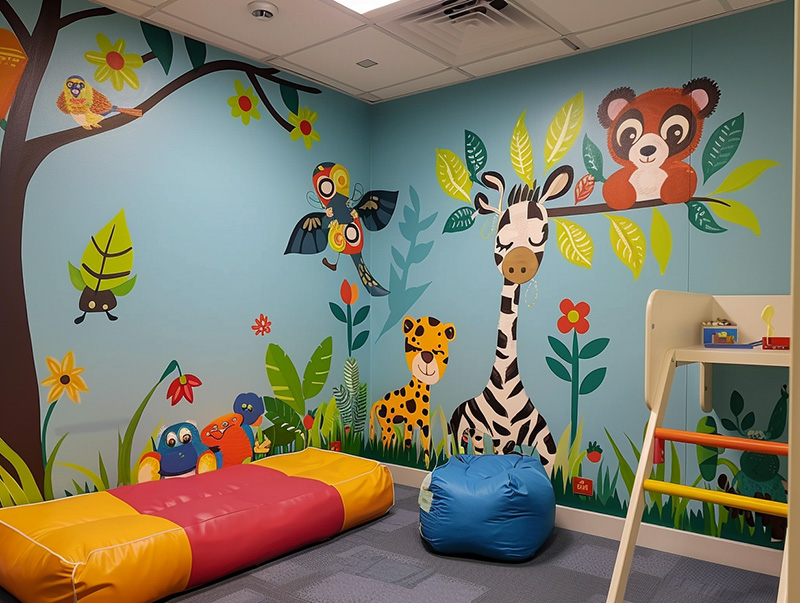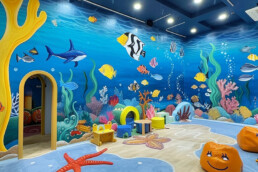If you’ve ever stepped into a well-designed nursery, you’ll understand the power of aesthetics in creating a lasting impression. Imagine wandering through a space where every element exudes warmth, creativity, and a sense of security – that’s the magic of nursery interior design. Now, picture this enchanting ambiance in the vibrant city of Dubai, where every detail is meticulously crafted to not only provide a nurturing environment but also to build a strong brand identity. Yes, nursery interior design goes beyond just aesthetics; it’s a strategic tool that can elevate childcare facilities’ marketing game to new heights in the competitive landscape of Dubai. In the bustling metropolis of Dubai, where innovation and luxury converge, childcare facilities are seizing the opportunity to differentiate themselves through unique interior design concepts. By blending elements of functionality, aesthetics, and branding, these nurseries are not just creating spaces for children to thrive but also establishing a distinct nursery brand identity that resonates with parents seeking excellence in early childhood education. Join us on a journey through the world of nursery interior design as we uncover how these creative spaces in Dubai serve as powerful marketing tools, captivating audiences and leaving a lasting imprint on the competitive market – proving that a well-designed environment is more than just a backdrop; it’s a strategic cornerstone in shaping perceptions and attracting families.
 Key Elements of Brand Identity in Nursery Interior Design
Key Elements of Brand Identity in Nursery Interior Design
When it comes to building a strong brand identity through nursery interior design in Dubai, there are several key elements that play a crucial role. These elements not only create a visually appealing space but also communicate the values and essence of the brand. Let’s explore some of these key elements:
1. Color Palette: The choice of colors in nursery interior design can have a significant impact on brand identity. Colors evoke emotions and can convey specific messages. For example, soft pastel colors like pink and blue are often associated with nurseries, while vibrant and bold colors can create a sense of energy and excitement. It’s important to select colors that align with the brand’s personality and target audience.
2. Branding Elements: Incorporating branding elements into nursery interior design is an effective way to reinforce brand identity. This can include using the brand logo, typography, or even custom patterns that reflect the brand’s visual language. By integrating these elements seamlessly into the design, nurseries can create a cohesive and recognizable brand experience for parents.
3. Theme and Storytelling: A well-defined theme or storytelling concept can help nurseries stand out from the competition and create a memorable experience for parents and children alike. Whether it’s an enchanted forest, outer space adventure, or a multicultural celebration, incorporating themes into nursery interior design adds depth and personality to the space.
4. Texture and Materials: The choice of textures and materials in nursery interior design can contribute to the overall ambiance and reinforce the brand’s identity. For example, natural materials like wood or organic fabrics can create a warm and nurturing environment, while sleek surfaces may convey modernity or luxury.
5. Lighting: Lighting plays a crucial role in setting the mood and atmosphere of a nursery. By strategically using different types of lighting, such as natural light, task lighting, and ambient lighting, nurseries can create a welcoming and comfortable space that aligns with their brand identity.
6. Customized Furniture and Fixtures: Investing in customized furniture and fixtures allows nurseries to create a unique and branded environment. From custom-designed cribs to branded storage solutions, these elements not only enhance the functionality of the space but also contribute to the overall brand experience.
Incorporating Cultural Influences in Nursery Design in Dubai
Dubai is a melting pot of cultures, making it an ideal location for nurseries to incorporate cultural influences into their interior design. By embracing diversity and celebrating different traditions, nurseries can create inclusive spaces that resonate with parents from various backgrounds. Here are some ways nurseries in Dubai can incorporate cultural influences into their design:
1. Artwork and Decorations: Displaying artwork or decorations that represent different cultures can add depth and richness to nursery interiors. This can include traditional paintings, sculptures, or even textiles that showcase the heritage of different communities.
2. Multilingual Signage: Using multilingual signage throughout the nursery not only helps children develop language skills but also demonstrates inclusivity towards diverse cultures. Parents will appreciate seeing their native language represented within the nursery environment.
3. Cultural Celebrations: Organizing cultural celebrations or events within the nursery provides an opportunity for children to learn about different traditions while fostering a sense of community among parents from various backgrounds.
4. Storytelling: Incorporating stories from different cultures into daily activities or reading sessions exposes children to diverse narratives and promotes cultural understanding. This can be done through books, puppets, or interactive storytelling sessions.
5. Traditional Games and Toys: Including traditional games and toys from different cultures in the nursery’s play area encourages children to explore and appreciate diversity. It also provides an opportunity for children to learn about different customs and traditions through play.
Color Psychology and Its Impact on Branding in Nurseries
Color psychology plays a significant role in branding nurseries as it can evoke specific emotions and influence parents’ perceptions. Here are some key color associations and their impact on branding in nurseries:
1. Blue: Blue is often associated with calmness, trust, and reliability. Using shades of blue in nursery interior design can create a sense of tranquility and establish trust with parents who prioritize a peaceful environment for their children.
2. Pink: Pink is commonly associated with femininity, nurturing, and warmth. It is often used in nursery designs to create a soft and gentle atmosphere that appeals to parents seeking a nurturing environment for their little ones.
3. Green: Green symbolizes nature, growth, and harmony. Incorporating shades of green into nursery interiors can convey a sense of freshness, healthiness, and environmental consciousness – qualities that many parents value when choosing a nursery for their child.
4. Yellow: Yellow is associated with happiness, energy, and optimism. Using pops of yellow in nursery design can create a vibrant and cheerful atmosphere that appeals to parents looking for an energetic environment where their children can thrive.
5. Neutral Colors: Neutral colors like beige, gray, or white are often used as the base palette in nursery interior design as they provide a versatile backdrop that can be easily complemented with other colors. These colors also convey a sense of simplicity, cleanliness, and sophistication.
Maximizing Space and Functionality for Brand Consistency
Maximizing space and functionality is essential in nursery interior design to ensure brand consistency and create an optimal environment for children’s growth and development. Here are some strategies to achieve this:
1. Efficient Layout: Designing an efficient layout that maximizes the available space is crucial in nurseries. This includes carefully planning the placement of furniture, play areas, storage solutions, and circulation paths to create a seamless flow that optimizes both functionality and aesthetics.
2. Multi-purpose Furniture: Investing in multi-purpose furniture allows nurseries to make the most of limited space while maintaining brand consistency. For example, cribs with built-in storage or modular furniture that can adapt to different activities help create a versatile environment.
3. Storage Solutions: Adequate storage is essential in nurseries to keep toys, supplies, and personal belongings organized. Incorporating branded storage solutions not only enhances the overall aesthetic but also reinforces brand consistency throughout the space.
4. Flexible Spaces: Designing flexible spaces that can adapt to different activities or age groups ensures long-term functionality. For example, using movable partitions or modular furniture allows nurseries to transform spaces based on specific needs or changing enrollment numbers.
Crafting a Warm and Welcoming Atmosphere
A warm and welcoming atmosphere is crucial in nursery interior design as it sets the tone for children’s first experiences away from home. Here are some elements that contribute to crafting such an atmosphere:
1. Soft Lighting: Soft lighting creates a cozy and calming ambiance that helps children feel safe and secure. Using warm-toned light fixtures or adding dimmers to existing lighting can create a nurturing environment.
2. Comfortable Seating: Providing comfortable seating options for parents within the nursery space fosters a welcoming atmosphere. This allows parents to spend quality time with their children and feel involved in their early learning experiences.
3. Natural Elements: Incorporating natural elements like plants, natural materials, or nature-inspired artwork brings a sense of warmth and connection to the outdoors. It creates a soothing environment that promotes well-being and relaxation.
4. Personalized Touches: Adding personalized touches, such as displaying children’s artwork or photographs, creates a sense of belonging and familiarity within the nursery space. It also helps parents feel connected to their child’s daily experiences.
Incorporating Creativity into Every Corner
Creativity is at the heart of nursery interior design, as it stimulates children’s imagination and supports their cognitive development. Here are some ways nurseries can incorporate creativity into every corner:
1. Art Stations: Designating specific areas for art activities encourages children to explore their creativity through painting, drawing, or sculpting. Providing easy access to art supplies and displaying children’s artwork inspires imagination.
2. Interactive Wall Features: Installing interactive wall features like magnetic boards, chalkboards, or sensory walls engages children in hands-on activities while promoting creativity and problem-solving skills.
3. Playful Learning Spaces: Creating dedicated spaces for different types of play – such as imaginative play areas, construction zones, or reading nooks – encourages exploration and stimulates creativity in children.
4. Themed Learning Corners: Designing themed learning corners based on specific topics or interests sparks children’s curiosity and encourages them to explore new ideas. These corners can be dedicated to science, nature, music, or any other subject that aligns with the nursery’s curriculum.
By incorporating these key elements of brand identity in nursery interior design, nurseries in Dubai can create spaces that not only provide a nurturing environment for children but also serve as powerful marketing tools. The carefully crafted design elements, cultural influences, color psychology, functional layouts, warm atmospheres, and creative touches all contribute to building a strong brand identity that attracts parents seeking excellence in early childhood education.
Related Posts
1 mai 2024
Creating Calming Spaces for Children in Dubai Nurseries
Nurturing tranquility within nursery…





